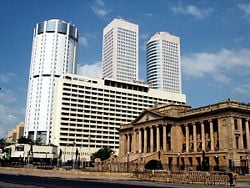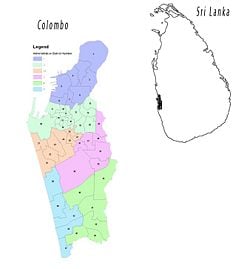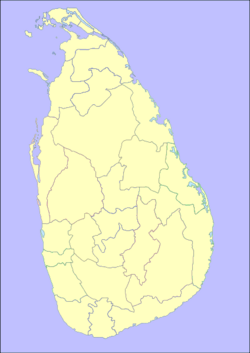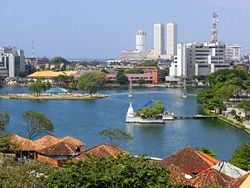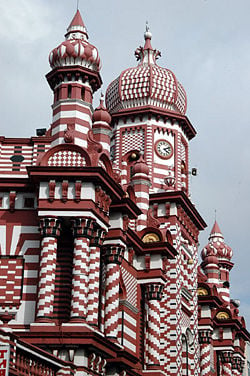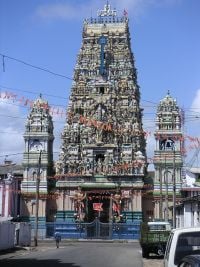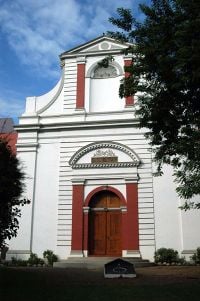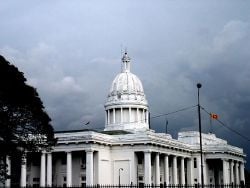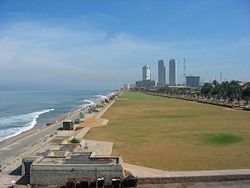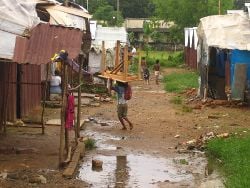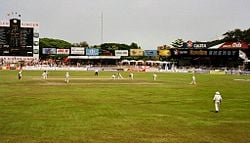Difference between revisions of "Colombo" - New World Encyclopedia
Mike Butler (talk | contribs) |
Rosie Tanabe (talk | contribs) |
||
| (79 intermediate revisions by 7 users not shown) | |||
| Line 1: | Line 1: | ||
| + | {{Images OK}}{{Submitted}}{{Approved}}{{copyedited}} | ||
{{Infobox Settlement | {{Infobox Settlement | ||
|official_name = Colombo | |official_name = Colombo | ||
| − | |image_skyline | + | |native_name = '''කොළඹ''' <br> '''கொழும்பு''' |
| − | |image_caption = The skyline of the Fort area. The twin towers of the [[Worldwide world trade center|World Trade Center]] building are in the background, with the [[Bank of Ceylon]] tower to their left and the Presidential Secretariat in the foreground. | + | | settlement_type = City |
| − | |image_flag = | + | |image_skyline = Wtccolombo.jpg |
| − | |image_seal = | + | |imagesize = |
| + | |image_caption = The skyline of the Fort area. The twin towers of the [[Worldwide world trade center|World Trade Center]] building are in the background, with the [[Bank of Ceylon]] tower to their left and the Presidential Secretariat in the foreground. | ||
| + | |image_flag = | ||
| + | |image_seal = | ||
|image_map = Colombo Map.jpg | |image_map = Colombo Map.jpg | ||
|map_caption = Map of Colombo showing its administrative districts. | |map_caption = Map of Colombo showing its administrative districts. | ||
|pushpin_map = Sri Lanka | |pushpin_map = Sri Lanka | ||
| − | |subdivision_type = | + | |pushpin_map_caption = Map of Sri Lanka showing the location of Colombo. |
| − | |subdivision_name = [[ | + | |coordinates_region = LK |
| − | | | + | |subdivision_type = [[Countries of the world|Country]] |
| − | | | + | |subdivision_name = [[Sri Lanka]] |
| − | |leader_title1 = [[ | + | |subdivision_type1 = [[Provinces of Sri Lanka|Province]] |
| − | | | + | |subdivision_name1 = [[Western Province, Sri Lanka|Western Province]] |
| − | |area_magnitude = | + | |subdivision_type2 = [[Districts of Sri Lanka|District]] |
| + | |subdivision_name2 = [[Colombo District]] | ||
| + | |leader_title=Municipal Council | ||
| + | |leader_name=[[Colombo Municipal Council]] | ||
| + | |leader_title1=Headquarters | ||
| + | |leader_name1=[[Town Hall (Colombo)|Town Hall]] | ||
| + | |leader_title2=[[Mayor of Colombo|Mayor]] | ||
| + | |leader_name2= [[Mohommad Muzammil]] | ||
| + | |language = Sinhala, Tamil, English | ||
| + | |area_magnitude = | ||
|area_total_km2 = 37.31 | |area_total_km2 = 37.31 | ||
|area_total_sq_mi = 14.4 | |area_total_sq_mi = 14.4 | ||
| − | |area_land_km2 = | + | |area_land_km2 = |
| − | |area_land_sq_mi = | + | |area_land_sq_mi = |
| − | |area_water_km2 = | + | |area_water_km2 = |
| − | |area_water_sq_mi = | + | |area_water_sq_mi = |
| − | |population_as_of = 2001<ref name="census">[http://www.citypopulation.de/SriLanka.html Census July 17, 2001 (via | + | |population_as_of = 2001<ref name="census">[http://www.citypopulation.de/SriLanka.html Census July 17, 2001] (via Citypopulation.de) Retrieved October 17, 2011. </ref> |
| − | |population_total = | + | |population_total = 647,100 |
| − | |population_metro = | + | |population_metro = 5,648,000 (2006) |
| − | |population_density_km2 = | + | |population_density_km2 = 17344 <!--Don't include commas!--> |
| − | |timezone = [[Time zone#UTC | + | |timezone = [[Time zone#UTC + 6, F|Sri Lanka Standard Time Zone]] |
| − | |utc_offset = + | + | |utc_offset = +05:30 |
| − | + | |latd=6 |latm=56 |lats=04 |latNS=N |longd=79 |longm=50 |longs=34 |longEW=E | |
| − | |||
| − | |latd=6 |latm= | ||
|website = [http://www.cmc.lk/ www.cmc.lk] | |website = [http://www.cmc.lk/ www.cmc.lk] | ||
| − | |footnotes = | + | |footnotes = |
}} | }} | ||
| − | |||
| − | + | '''Colombo''' ([[Sinhala language|Sinhala]]: [[Image:Colombo sinhala.jpg|40px]], {{pronounced|ˈkoləmbə}}; [[Tamil language|Tamil]]: கொழும்பு) is the largest city and commercial capital of [[Sri Lanka]]. Located on the west coast of the island and adjacent to [[Sri Jayawardenepura Kotte]], the administrative capital of Sri Lanka, Colombo is a busy and vibrant [[city]] with a mixture of modern and colonial buildings. | |
| − | + | Due to its large [[harbor]] and its strategic position, Colombo has been a seaport for more than 2,000 years. However, it only became the capital of the nation after Sri Lanka was ceded to the [[British Empire]] in 1815. Its status as capital was retained when the nation became independent in 1948. In 1978, when administrative functions were moved to nearby [[Kotte]], Colombo kept its position as Sri Lanka's commercial capital. | |
| + | |||
| + | Sri Lanka is a strategic naval link between [[West Asia]] and [[Southeast Asia]]. It served as an important Allied base during [[World War II]]. After the nation gained independence from [[Great Britain|Britain]] in 1948, and several decades of stable democracy and economic progress, it became embroiled in [[civil war]], and its prosperity was undermined by deadly violence. | ||
| + | {{toc}} | ||
| + | The largest city and economic capital of its island nation, Colombo is restricted by the nation's political turbulence that has continued since independence. | ||
== Geography == | == Geography == | ||
| − | + | The name Colombo, introduced by the Portuguese in 1505, is believed to be derived from the classical [[Sinhala language|Sinhalese]] name ''Kolon thota,'' meaning "port on the river [[Kelani River|Kelani]]."<ref name="so1">Padma Edirisinghe, Colombo--then and now, ''The Sunday Observer''.</ref> It has also been suggested that the name may be derived from the Sinhalese name, ''Kola-amba-thota,'' which means "Harbor with leafy mango trees."<ref name="we1">''World Executive,'' [http://www.worldexecutive.com/cityguides/colombo Colombo City Guide.] Retrieved September 18, 2008.</ref> | |
| − | The name | ||
| − | + | The island nation of [[Sri Lanka]] lies in the [[Indian Ocean]], to the southwest of the [[Bay of Bengal]] and to the southeast of the [[Arabian Sea]]. It is separated from the [[India|Indian subcontinent]] by the [[Gulf of Mannar]] and the [[Palk Strait]]. The city of Colombo lies on the island's western shores. | |
| − | + | Colombo's geography is a mix of land and water. The city has many canals and, in the heart of the city, the 65-hectare (160 acre) distinctive [[Beira Lake]], which was used for centuries by colonists to defend the city. It remains a popular attraction, hosting [[regattas]], and [[theater|theatrical events]] on its shores. The northern and northeastern border of the city of Colombo is formed by the [[Kelani River]]. | |
| − | + | Colombo’s [[climate]] is fairly temperate throughout the year. From March to April, the [[temperature]] averages around 88°F (31°C) maximum, with little relative diurnal range, although this is more marked in the drier winter months, where minimums average 72°F (22°C). The only change occurs during the [[monsoon]] seasons from May to August, and October to January, when heavy [[rain]]s can be expected. Mean annual precipitation is 94 inches (2400 mm). | |
| − | The fort, the fortifications of which are long gone, and the area outside the fort, the Pettah, are the oldest districts. The fort is | + | Environmental issues include coastal degradation from increased [[water pollution|pollution]]; freshwater resources being polluted by industrial wastes and sewage runoff; inadequate waste disposal; and [[air pollution]]. |
| + | |||
| + | The fort, the fortifications of which are long gone, and the area outside the fort, the Pettah, are the oldest districts. The fort is the city's nerve center of government and commercial activity. The Pettah has small shops, markets, and sidewalk stalls. There, Main Street consists mostly of clothing shops, while each cross street specializes in a specific business, such as [[electronics]]s, [[cellular phones]], and fancy goods. The mile-long Sea Street is [[Sri Lanka]]'s [[gold]] market, and is full of [[jewelery]] shops. Cinnamon Gardens, south of Beira Lake, was where the Dutch grew [[cinnamon]]. | ||
== History == | == History == | ||
| − | [[ | + | [[Paleolithic]] human settlements have been discovered at excavations in several [[cave]] sites in the western plains region. The recorded history of [[Sri Lanka]] is usually taken to begin in the sixth century B.C.E., when the [[Indo-Aryan]] people, who are known as the [[Sinhalese]], migrated from [[India]]. As Colombo possesses a natural harbor, it was known to [[Roman Empire|Roman]], [[Arab]], and [[China|Chinese]] traders over 2,000 years ago. Arabian [[Muslim]]s whose prime interests were trade, began to settle in Colombo around the eighth century C.E., mostly because the port controlled much of the trade between the [[Sinhalese people|Sinhalese]] kingdoms and the outside world. |
| + | |||
| + | ===Portuguese arrive=== | ||
[[Image:Voclogo.jpg|right|thumb|250px|The VOC (Verenigde Oostindische Compagnie) logo of [[Dutch East India Company]] on the gates of ''Wolvendaal'' church]] | [[Image:Voclogo.jpg|right|thumb|250px|The VOC (Verenigde Oostindische Compagnie) logo of [[Dutch East India Company]] on the gates of ''Wolvendaal'' church]] | ||
| − | [[Image: | + | [[Image:Colombo - Lake.jpg|thumb|250px|The Beira Lake, the Seema Malakaya temple and the gallery island can be seen in lake.]] |
| − | [[Image: | + | [[Image:Jami-Ul-Alfar.jpg|250px|thumb|right|250px|The Jami Ul Alfar mosque, Pettah is one of the oldest mosques in Colombo]] |
| − | + | The first [[Europe]]ans to visit [[Sri Lanka]] were the [[Portugal|Portuguese]]: [[Francisco de Almeida]] arrived in 1505, finding the [[island]] divided into seven warring kingdoms and unable to fend off intruders. The Portuguese founded a fort at [[Colombo]] in 1517 and gradually extended control over the coastal areas. In 1592, the Sinhalese moved their capital to the more secure inland city of Kandy. Intermittent warfare continued through the sixteenth century. | |
| − | |||
| − | |||
| − | |||
| − | |||
| − | |||
| − | |||
| − | |||
| − | |||
| − | |||
| − | |||
| − | |||
| − | |||
| − | |||
| − | |||
| − | |||
| − | + | In 1638, the [[Netherlands|Dutch]] signed a treaty with King Rajasinha II of [[Kandy]] to help in his war against the Portuguese in exchange for a monopoly of the island's trade. Although at that time, much of the island came under the domain of European powers, the interior, hilly region of the island remained independent, with its capital in Kandy. By 1660, the Dutch controlled the whole island except the kingdom of Kandy. A mixed Dutch-Sinhalese people known as [[Burgher]] peoples are a legacy of Dutch rule. | |
| − | [[ | ||
| − | + | ===British capture Colombo=== | |
| − | + | Although the [[United Kingdom|British]] captured Colombo in 1796, it remained a [[British Armed Forces|British military]] outpost until the Kandyan Kingdom was ceded to them in 1815, and they made Colombo the capital of the newly created [[British overseas territories|crown colony]] of [[Ceylon]]. Unlike the Portuguese and Dutch before them, whose primary use of Colombo was as a military fort, the British began constructing houses and other civilian structures around the fort. | |
| − | |||
| − | |||
| − | |||
| − | |||
| − | |||
| − | |||
| − | |||
| − | |||
| − | |||
| − | |||
| − | |||
| − | + | The city of Colombo was established as the island's administrative center, and the British established modern [[school]]s, [[college]]s, [[road]]s and [[church]]es that brought Western [[education]] and [[culture]] to the native people. [[English language|English]] was established as the main [[language]] for governance, until after independence. John Macdowell of the [[Madras Presidency|Madras]] Service was the first to hold the office of "collector" to administer Colombo. Then, in 1833, the government agent of the Western Province was charged with the administration of the city. | |
| − | + | Centuries of [[Colonialism|colonial rule]] had meant a decline of indigenous administration of the city, and in 1865 the British conceived a municipal council as a means of training the local population in [[self-governance]]. The [[Legislative Council of Ceylon]] constituted the Colombo Municipal Council in 1865 and the council first met on January 16, 1866. At the time, the population of the region was around 80,000. | |
| − | |||
| − | |||
| − | |||
| − | |||
| − | |||
| − | |||
| − | |||
| − | |||
| − | |||
| − | |||
| − | |||
| − | |||
| − | === | + | ===Assembly partly elected=== |
| − | + | It was not until 1909 that constitutional development began with a partly-elected assembly. [[Universal suffrage]] was introduced in 1931, over the protests of the Sinhalese, [[Tamil]] and Burgher elite who objected to the common people being allowed to vote. In 1919, the ''Ceylon National Congress'' (CNC) was founded to agitate for greater autonomy. The [[Marxism|Marxist]] Lanka Sama Samaja Party (LSSP), which grew out of the [[Youth Leagues]] in 1935, demanded independence, and the replacement of English as the official language by Sinhala and [[Tamil language|Tamil]]. | |
| − | + | ===Second World War=== | |
| + | During [[World War II]], a large segment of the [[Great Britain|British]] and [[United States|American]] fleet were deployed on the island, as were tens of thousands of soldiers committed to the war against [[Japan]] in [[Southeast Asia]]. There was considerable opposition to the war in [[Sri Lanka]], and the LSSP leaders of the pro-independence agitation were arrested. On April 5, 1942, the Japanese Navy bombed Colombo and LSSP leaders were able to escape. Several of them fled to [[India]], where they participated in the struggle there, but a sizable contingent remained, led by Robert Gunawardena. | ||
| − | + | ===Independence=== | |
| − | + | On February 4, 1948, the country won independence as the [[Commonwealth of Ceylon]]. Don Stephen Senanayake became the first Prime Minister of Sri Lanka. He died in 1952, and was succeeded first by his son Dudley Senanayake, and in 1953—after a general strike by the Left parties—by a relative, John Kotelawala. In 1957, British bases were removed and Sri Lanka became non-aligned. Dissatisfaction with the economic situation brought Senanayake back to office in 1965, but this government fared no better, since Sri Lanka's problems were caused by the declining market for its exports, [[tea]], [[coffee]], and [[rubber]]. In 1968, Bandaranaike formed a coalition, the Sri Lanka United Front with the LSSP and the Communist Party of Sri Lanka, which swept the 1970 polls on a platform of [[socialism]]. In 1972, the country became a republic within the Commonwealth, and the name was changed to Sri Lanka. On July 21, 1960, [[Sirimavo Bandaranaike]] became the first female head of government in post-colonial [[Asia]] when she took office as prime minister. | |
| − | |||
| − | |||
| − | |||
| − | |||
| − | |||
| − | |||
| − | |||
| − | |||
| − | |||
| − | |||
| − | === | + | ===Political conflict=== |
| − | + | In the 1970s, political conflicts emerged between the Sinhalese and Tamil communities. The Tamil community sought increased regional autonomy. In 1971, the [[People's Liberation Front]] (JVP) launched an unsuccessful rebellion. The JVP established itself as a voice of extreme Sinhalese [[chauvinism]]. In the 1980s, the [[Liberation Tigers of Tamil Eelam]] (LTTE) demanded an independent state of ''Ealam'' in north-eastern Sri Lanka. A 1986 peace accord, brokered by India, failed by 1988, when Indian peacekeepers were drawn into a military conflict with the LTTE. Sri Lankan nationalists sought the exit of Indian troops, and by the year 2000, up to 50,000 people had been killed. A tentative ceasefire has restored [[peace]] as the government and the LTTE engage in diplomacy under the mediation of [[Norway]]. | |
| − | |||
| − | + | [[Image:Templecolombo0784.JPG|200px|thumb|The [[Murugan]] [[Hindu]] temple in slave island area.]] | |
| − | + | [[Image:Wolvendhal1749.jpg|200px|thumb|Colombo's colonial heritage is visible throughout the city, as in the historical ''Wolvendaal'' church, established by the Dutch in 1749.]] | |
| − | |||
==Government== | ==Government== | ||
| − | [[Image:TownhallColombo.jpg|thumb | + | [[Image:TownhallColombo.jpg|thumb|250px|The Colombo City Town Hall in Cinnamon Gardens houses the Town Council and other municipal offices.]] |
| − | Sri Lanka is described as a democratic socialist republic in which the president, who is both the chief of state and head of government, is elected by popular vote for a six-year term. The cabinet is appointed by the president in consultation with the prime minister. The unicameral parliament consists of 225 members elected by popular vote on the basis of an open-list, proportional representation system by electoral district to serve six-year terms. For administrative purposes, the nation is divided into eight provinces. | + | [[Sri Lanka]] is described as a democratic socialist republic in which the president, who is both the chief of state and head of government, is elected by popular vote for a six-year term. The cabinet is appointed by the president in consultation with the prime minister. The unicameral parliament consists of 225 members elected by popular vote on the basis of an open-list, proportional representation system by electoral district to serve six-year terms. For administrative purposes, the nation is divided into eight provinces. |
| − | The Colombo Metropolitan Region (CMR) encompasses the country's administrative capital Kotte and Colombo, which has a mayor-council form of government with elections held once in five years. The city government provides sewer, road management and waste management services | + | The Colombo Metropolitan Region (CMR) encompasses the country's administrative capital Sri Jayawardanapura Kotte and Colombo, which has a mayor-council form of government with elections held once in five years. The city government provides sewer, road management and waste management services. For [[water]], [[electricity]], and [[telephone]] utility services, the council liaises with the water supply and drainage board, the Ceylon electricity board, and telephone service providers. |
| − | The | + | The Sri Lanka Police, the main law enforcement agency of the island, liaise with the municipal council, but are under the [[Ministry of Defence (Sri Lanka)|Ministry of Defence]] of the central government. |
| − | Colombo was the capital of the coastal areas controlled by the Portuguese, Dutch and the British from the 1700s to | + | Colombo was the capital of the coastal areas controlled by the Portuguese, Dutch, and the British from the 1700s to 1815 when the British gained control of the entire island following the Kandian convention. Since then until the 1980s the national capital of the island was Colombo. During the 1980s, plans were made to move the administrative capital to Sri Jayawardanapura Kotte to make way for commercial activities. As a primary step, the Parliament was moved to Kotte and several ministries and departments were also moved. However, the move was never completed, and many governmental institutions remain in Colombo. |
==Economy== | ==Economy== | ||
[[Image:Colombo - Galle Face.jpg|thumb|right|250px|Colombo is the hub of Sri Lanka's economic activity, with many major events taking place around the Galle Face Green.]] | [[Image:Colombo - Galle Face.jpg|thumb|right|250px|Colombo is the hub of Sri Lanka's economic activity, with many major events taking place around the Galle Face Green.]] | ||
| − | [[Image:Colombo | + | [[Image:Slum street after rain - Colombo.jpg|thumb|250px|Slum street in Colombo after rain.]] |
| − | The Sri Lanka government abandoned statist economic policies | + | The Sri Lanka government abandoned statist economic policies in 1977, for more market-oriented policies, export-oriented trade, and encouragement of foreign investment. Changes in government have brought policy reversals, so that in 2008, the ruling Sri Lanka Freedom Party had a more statist economic approach, which seeks to reduce [[poverty]] by steering investment to disadvantaged areas, developing small and medium enterprises, promoting [[agriculture]], and expanding the already enormous [[civil service]]. Sri Lanka's most dynamic sectors, in 2008, were [[food processing]], [[textile]]s and apparel, food and beverages, port construction, [[telecommunications]], and [[insurance]] and [[banking]]. |
| − | |||
| − | Sri Lanka's most dynamic sectors | ||
| − | |||
| − | |||
| − | |||
| − | |||
| − | |||
| − | |||
| − | |||
| − | |||
| − | Colombo | + | Colombo is the commercial center of Sri Lanka. The head offices of banks, the state monopoly Insurance Corporation, brokerage houses, and government corporations are located there. High land prices have contributed to a building boom of high rise condominiums. South Asia's second tallest building, the 40-story [[Twin Tower]] [[World Trade Center (Colombo)|World Trade Center]] is situated in the Fort district. |
| − | [[ | + | Almost all major media businesses in Sri Lanka operate from Colombo. Sri Lanka per capita GDP was estimated at US$4100 in 2007. Colombo's manufacturing focuses on processing of raw materials for export. Industries include [[chemical]]s, textiles, [[glass]], [[cement]], [[leather]] goods, [[furniture]], and [[jewelry]]. |
| − | + | Colombo's central bus stand and the Fort Railway Station functions as the island's hub for bus and rail transport. Up until the 1970s the city had a [[tram]] service, which was discontinued, in favor of an extensive [[bus]] service. Other means of transport include [[auto rickshaws]] ("three wheelers") and [[taxicab]]s. Construction of the Colombo Metro Rail, a [[Rapid transit|Mass Rapid Transit]] [[Rail transport|railway system]], similar to that of other advanced [[Asia]]n cities, had begun by 2008. | |
| − | + | [[Bandaranaike International Airport]] serves the city for all international flights while the [[Ratmalana Airport]] serves all local flights. The Colombo port, which dates back to the fourteenth century, was expanded after 1948 with the construction of the Queen Elizabeth Quay, 16 alongside berths, transit sheds, and warehouses. It was modernized in the 1980s, with cranes, gantries, and other container terminal equipment, and the access channel was deepened in the 1990s. The port of Colombo was rated as one of the top 35 ports in the world by 2008. | |
| − | [[ | ||
| − | |||
| − | Colombo | ||
| − | + | == Demographics and culture== | |
| − | + | [[Image:InsideSeema.jpg|thumb|right|250px|The ''Seema Malakaya'' of the Gangarama Temple in the [[Beira Lake|''Beira'' Lake]] in the ''Slave Island'' area, is one of many religious structures in Colombo.]] | |
| − | |||
| − | |||
| − | |||
| − | |||
| − | |||
| − | |||
| − | == | ||
| − | [[Image: | ||
| − | [[ | ||
| − | |||
| − | |||
| − | |||
| − | |||
[[Image:SCC Ground Colombo.jpg|right|thumb|250px|A Test match between Sri Lanka and England at the [[Sinhalese Sports Club|SCC]] Ground, Colombo, March 2001.]] | [[Image:SCC Ground Colombo.jpg|right|thumb|250px|A Test match between Sri Lanka and England at the [[Sinhalese Sports Club|SCC]] Ground, Colombo, March 2001.]] | ||
| + | Colombo is the most populated city in Sri Lanka, with 642,163 people living within the limits of this multi-ethnic, multi-cultural city. [[Sinhala people|Sinhalese]] make up 41.36 percent of the city's [[population]], [[Sri Lankan Moors|Moors]] 23.87 percent, and [[Sri Lanka Tamils|Tamils]] 28.91 percent. There are small communities of people with [[China|Chinese]], [[Portugal|Portuguese]], [[Netherlands|Dutch]], [[Sri Lankan Malays|Malay]] (1.73 percent), and [[India]]n Tamil (2.17 percent) origins living in the city, as well as numerous [[Europe]]an [[expatriates]]. | ||
| − | + | [[Sinhalese language|Sinhala]] and [[Tamil language|Tamil]] are the two official [[language]]s. [[English language|English]] is spoken by approximately 10 percent of the population, and is widely used for [[education]], scientific, and commercial purposes. Members of the Burgher community (male-line descendants]] of [[Europe]]an colonists from the sixteenth to twentieth centuries (Eurasian descendants of [[Portuguese]], [[Dutch]], and [[British]] men and local women) speak variant forms of [[Portuguese Creole]] and [[Dutch language|Dutch]]. | |
| − | |||
| − | |||
| − | + | Approximately 68 percent of Sri Lankan people are adherents of [[Buddhism]]. [[Theravada]] Buddhism is the predominant school. [[Hinduism]] is practiced by 18 percent, mainly from the Tamil community, [[Christianity]] is practiced by up to eight percent, especially by the Portuguese and Dutch Burgher people. While most Sri Lankan Christians are [[Catholicism|Catholics]], there are also significant numbers who adhere to [[Dutch Reformed Church]] and the [[Anglican Communion]]. | |
| − | The | + | The [[Colombo Medical School]] and the [[Sri Lanka Law College|Colombo Law College]] were established in the 1870s. The Ceylon University College was established in 1913, followed by the formation of the [[University of Ceylon]], which had a campus in Colombo. The [[University of Colombo]] and the [[University of the Visual and Performing Arts]] are state universities located in Colombo, while the [[Sri Lanka Institute of Information Technology]] has a metropolitan campus there. |
| − | + | The most popular sport in Sri Lanka is [[cricket]]. The country won the 1996 [[Cricket World Cup]] and became runners up in 2007. Colombo has two international cricket stadiums, the [[Sinhalese Sports Club]]'s [[Cricket Stadium|cricket stadium]] and [[R. Premadasa Stadium]]. [[Rugby Union|Rugby]] is a popular sport at the club and school level. | |
| − | + | ==Places of interest== | |
| + | Buildings from the Portuguese, the Dutch and the British eras stand as reminders of the city's turbulent past. The Dutch Hospital, now the [[Colombo Dutch Museum]], is the oldest building in the fort area. The [[President's House, Colombo|President's House]] (formally the Queen's House) had originally been the Dutch governors house. | ||
| − | + | Buildings of the British era include the old Parliament building, which is now the [[Presidential Secretariat]], the Republic Building which houses the [[Ministry of Foreign Affairs (Sri Lanka)|Ministry of Foreign affairs]], the Treasury building, the old General Post Office, the Prime Minister's Office, and the [[mathematics]] department of the [[University of Colombo]]. Notable commercial buildings of the British era include, the [[Galle Face Hotel]], ''Cargills & Millers'' complex, Grand Oriental Hotel. Several old clubs, including the Orient Club, the 80s Club, and the Colombo Cricket Club, give a glimpse of the British lifestyle. | |
| − | + | The Galle Face Green is the city's largest and most elegant [[promenade]]. Lined with [[palm|palm trees]] and adjacent to the coast, this mile-long stretch in the heart of the city is especially busy on Fridays and Saturdays. | |
| − | |||
| − | |||
| − | |||
| − | |||
| − | |||
| − | |||
| − | |||
| + | Colombo's most beautiful festival is the celebration of [[Gautama Buddha|Buddha's]] birth, enlightenment and death, which takes place in mid-May and lasts a week. During this festival, much of the city is decorated with lanterns, lights and special displays of light, known as ''Thoran''. | ||
| − | + | Colombo has several [[performing arts]] centers. The most famous are the Lionel Wendt Theater, the Elphinstone and the Tower Hall. The [[Navarangahala]] is the country's first [[national theater]]. | |
| − | Colombo has | ||
| + | The [[Colombo National Museum|National Museum of Colombo]], established in 1877, houses the [[crown jewel]]s and throne of the last king of the [[Kingdom of Kandy]], [[Sri Vikrama Rajasinha]]. The [[Colombo Dutch Museum]] details Dutch colonial history. There is only a small collection of Sri Lankan masterpieces at the Art Gallery in Green Path. | ||
| − | === | + | ==Looking to the future== |
| + | Colombo is both a modern and an ancient [[city]]. Possessing a natural harbor, it was known to [[Roman Empire|Roman]], [[Arab]], and [[China|Chinese]] traders more than 2,000 years ago. It has been controlled by various foreign nations throughout its history. Buildings from the Portuguese, the Dutch and the British eras stand as reminders of the turbulent past. | ||
| − | + | Located on Sri Lanka's west coast, just south of the [[Kelani River]], it is a principal port of the [[Indian Ocean]]. Its natural harbor, which drew foreigners to its doorstep in ancient days, has been expanded and is today one of the largest artificial harbors in the world. The majority of the nation's foreign trade flows through its ports. | |
| − | + | ||
| − | + | Colombo is the largest city and commercial capital of Sri Lanka, and is home to many of the national governmental institutions. Known as a busy and vibrant city, it is nonetheless restricted by the political turbulence that has continued since independence. The demands of the [[Tamil Tigers]] separatist fighters has yet to be resolved, and conflict between ethnic and caste lines continues. [[Poverty]] remains, and successive governments have seesawed between state and market-oriented solutions to raise GDP. | |
| − | |||
| − | |||
| − | |||
| − | |||
| − | |||
| − | |||
| − | |||
| − | |||
| − | |||
| − | |||
| − | |||
| − | |||
| − | |||
| − | |||
| − | |||
| − | |||
| − | |||
| − | |||
| − | |||
| − | |||
| − | |||
| − | |||
| − | |||
| − | |||
| − | |||
| − | |||
| − | |||
| − | |||
| − | |||
| − | |||
| − | |||
| − | |||
| − | |||
| − | |||
| − | |||
| − | |||
| − | |||
| − | |||
| − | |||
| + | Sri Lanka rightly fought for its independence from foreign domination, but must now fight to overcome the barriers of race and ethnicity in order to experience real freedom and prosperity. Colombo's situation is intricately tied to that of Sri Lanka; its situation will improve hand in hand with that of its nation. | ||
== Notes == | == Notes == | ||
| − | + | <references/> | |
| − | == | + | == References == |
| − | * Brohier, Richard Leslie, and Ismeth Raheem | + | * Brohier, Richard Leslie, and Ismeth Raheem. ''Changing Face of Colombo, 1505-1972: Covering the Portuguese, Dutch, and British Periods''. Colombo: Lake House Investments, 1984. {{OCLC|12345141}} |
| − | * Dharmasena, K | + | * Dharmasena, K. ''The Port of Colombo, 1860-1939''. Colombo: Ministry of Higher Education (Sri Lanka), 1980. {{OCLC|59683734}} |
| − | * Perera, Nihal | + | * Perera, Nihal. ''Decolonizing Ceylon: Colonialism, Nationalism, and the Politics of Space in Sri Lanka''. New Delhi: Oxford University Press, 1999. ISBN 9780195646436 |
| + | * ''World Fact Book''. Sri Lanka. | ||
== External links == | == External links == | ||
| − | + | All links retrieved January 7, 2024. | |
| − | + | *[http://lankapura.com/ Historic photographs of Sri Lanka] | |
| − | *[http:// | + | *[http://www.olankatravels.com/blog/colombo-travel-guide/ Colombo Travel Guide] |
| − | |||
| − | *[http://www. | ||
| − | |||
| − | |||
| − | |||
| − | |||
| − | |||
| − | |||
[[Category:Geography]] | [[Category:Geography]] | ||
[[Category:Cities]] | [[Category:Cities]] | ||
| + | [[Category:Asia]] | ||
{{credit|Colombo|232690817|}} | {{credit|Colombo|232690817|}} | ||
Latest revision as of 22:37, 7 January 2024
| Colombo කොළඹ கொழும்பு |
|
| The skyline of the Fort area. The twin towers of the World Trade Center building are in the background, with the Bank of Ceylon tower to their left and the Presidential Secretariat in the foreground. | |
| Map of Colombo showing its administrative districts. | |
| Map of Sri Lanka showing the location of Colombo. | |
| Coordinates: {{#invoke:Coordinates|coord}}{{#coordinates:6|56|04|N|79|50|34|E|type:city | |
|---|---|
| name= }} | |
| Country | Sri Lanka |
| Province | Western Province |
| District | Colombo District |
| Government | |
| - Municipal Council | Colombo Municipal Council |
| - Headquarters | Town Hall |
| - Mayor | Mohommad Muzammil |
| Area | |
| - City | 37.31 km² (14.4 sq mi) |
| Population (2001[1]) | |
| - City | 647,100 |
| - Density | 17,344/km² (44,920.8/sq mi) |
| - Metro | 5,648,000 (2,006) |
| Time zone | Sri Lanka Standard Time Zone (UTC+05:30) |
| Website: www.cmc.lk | |
Colombo (Sinhala: ![]() , pronounced [ˈkoləmbə]; Tamil: கொழும்பு) is the largest city and commercial capital of Sri Lanka. Located on the west coast of the island and adjacent to Sri Jayawardenepura Kotte, the administrative capital of Sri Lanka, Colombo is a busy and vibrant city with a mixture of modern and colonial buildings.
, pronounced [ˈkoləmbə]; Tamil: கொழும்பு) is the largest city and commercial capital of Sri Lanka. Located on the west coast of the island and adjacent to Sri Jayawardenepura Kotte, the administrative capital of Sri Lanka, Colombo is a busy and vibrant city with a mixture of modern and colonial buildings.
Due to its large harbor and its strategic position, Colombo has been a seaport for more than 2,000 years. However, it only became the capital of the nation after Sri Lanka was ceded to the British Empire in 1815. Its status as capital was retained when the nation became independent in 1948. In 1978, when administrative functions were moved to nearby Kotte, Colombo kept its position as Sri Lanka's commercial capital.
Sri Lanka is a strategic naval link between West Asia and Southeast Asia. It served as an important Allied base during World War II. After the nation gained independence from Britain in 1948, and several decades of stable democracy and economic progress, it became embroiled in civil war, and its prosperity was undermined by deadly violence.
The largest city and economic capital of its island nation, Colombo is restricted by the nation's political turbulence that has continued since independence.
Geography
The name Colombo, introduced by the Portuguese in 1505, is believed to be derived from the classical Sinhalese name Kolon thota, meaning "port on the river Kelani."[2] It has also been suggested that the name may be derived from the Sinhalese name, Kola-amba-thota, which means "Harbor with leafy mango trees."[3]
The island nation of Sri Lanka lies in the Indian Ocean, to the southwest of the Bay of Bengal and to the southeast of the Arabian Sea. It is separated from the Indian subcontinent by the Gulf of Mannar and the Palk Strait. The city of Colombo lies on the island's western shores.
Colombo's geography is a mix of land and water. The city has many canals and, in the heart of the city, the 65-hectare (160 acre) distinctive Beira Lake, which was used for centuries by colonists to defend the city. It remains a popular attraction, hosting regattas, and theatrical events on its shores. The northern and northeastern border of the city of Colombo is formed by the Kelani River.
Colombo’s climate is fairly temperate throughout the year. From March to April, the temperature averages around 88°F (31°C) maximum, with little relative diurnal range, although this is more marked in the drier winter months, where minimums average 72°F (22°C). The only change occurs during the monsoon seasons from May to August, and October to January, when heavy rains can be expected. Mean annual precipitation is 94 inches (2400 mm).
Environmental issues include coastal degradation from increased pollution; freshwater resources being polluted by industrial wastes and sewage runoff; inadequate waste disposal; and air pollution.
The fort, the fortifications of which are long gone, and the area outside the fort, the Pettah, are the oldest districts. The fort is the city's nerve center of government and commercial activity. The Pettah has small shops, markets, and sidewalk stalls. There, Main Street consists mostly of clothing shops, while each cross street specializes in a specific business, such as electronicss, cellular phones, and fancy goods. The mile-long Sea Street is Sri Lanka's gold market, and is full of jewelery shops. Cinnamon Gardens, south of Beira Lake, was where the Dutch grew cinnamon.
History
Paleolithic human settlements have been discovered at excavations in several cave sites in the western plains region. The recorded history of Sri Lanka is usually taken to begin in the sixth century B.C.E., when the Indo-Aryan people, who are known as the Sinhalese, migrated from India. As Colombo possesses a natural harbor, it was known to Roman, Arab, and Chinese traders over 2,000 years ago. Arabian Muslims whose prime interests were trade, began to settle in Colombo around the eighth century C.E., mostly because the port controlled much of the trade between the Sinhalese kingdoms and the outside world.
Portuguese arrive
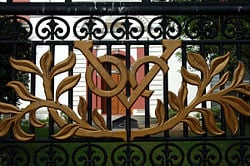
The first Europeans to visit Sri Lanka were the Portuguese: Francisco de Almeida arrived in 1505, finding the island divided into seven warring kingdoms and unable to fend off intruders. The Portuguese founded a fort at Colombo in 1517 and gradually extended control over the coastal areas. In 1592, the Sinhalese moved their capital to the more secure inland city of Kandy. Intermittent warfare continued through the sixteenth century.
In 1638, the Dutch signed a treaty with King Rajasinha II of Kandy to help in his war against the Portuguese in exchange for a monopoly of the island's trade. Although at that time, much of the island came under the domain of European powers, the interior, hilly region of the island remained independent, with its capital in Kandy. By 1660, the Dutch controlled the whole island except the kingdom of Kandy. A mixed Dutch-Sinhalese people known as Burgher peoples are a legacy of Dutch rule.
British capture Colombo
Although the British captured Colombo in 1796, it remained a British military outpost until the Kandyan Kingdom was ceded to them in 1815, and they made Colombo the capital of the newly created crown colony of Ceylon. Unlike the Portuguese and Dutch before them, whose primary use of Colombo was as a military fort, the British began constructing houses and other civilian structures around the fort.
The city of Colombo was established as the island's administrative center, and the British established modern schools, colleges, roads and churches that brought Western education and culture to the native people. English was established as the main language for governance, until after independence. John Macdowell of the Madras Service was the first to hold the office of "collector" to administer Colombo. Then, in 1833, the government agent of the Western Province was charged with the administration of the city.
Centuries of colonial rule had meant a decline of indigenous administration of the city, and in 1865 the British conceived a municipal council as a means of training the local population in self-governance. The Legislative Council of Ceylon constituted the Colombo Municipal Council in 1865 and the council first met on January 16, 1866. At the time, the population of the region was around 80,000.
Assembly partly elected
It was not until 1909 that constitutional development began with a partly-elected assembly. Universal suffrage was introduced in 1931, over the protests of the Sinhalese, Tamil and Burgher elite who objected to the common people being allowed to vote. In 1919, the Ceylon National Congress (CNC) was founded to agitate for greater autonomy. The Marxist Lanka Sama Samaja Party (LSSP), which grew out of the Youth Leagues in 1935, demanded independence, and the replacement of English as the official language by Sinhala and Tamil.
Second World War
During World War II, a large segment of the British and American fleet were deployed on the island, as were tens of thousands of soldiers committed to the war against Japan in Southeast Asia. There was considerable opposition to the war in Sri Lanka, and the LSSP leaders of the pro-independence agitation were arrested. On April 5, 1942, the Japanese Navy bombed Colombo and LSSP leaders were able to escape. Several of them fled to India, where they participated in the struggle there, but a sizable contingent remained, led by Robert Gunawardena.
Independence
On February 4, 1948, the country won independence as the Commonwealth of Ceylon. Don Stephen Senanayake became the first Prime Minister of Sri Lanka. He died in 1952, and was succeeded first by his son Dudley Senanayake, and in 1953—after a general strike by the Left parties—by a relative, John Kotelawala. In 1957, British bases were removed and Sri Lanka became non-aligned. Dissatisfaction with the economic situation brought Senanayake back to office in 1965, but this government fared no better, since Sri Lanka's problems were caused by the declining market for its exports, tea, coffee, and rubber. In 1968, Bandaranaike formed a coalition, the Sri Lanka United Front with the LSSP and the Communist Party of Sri Lanka, which swept the 1970 polls on a platform of socialism. In 1972, the country became a republic within the Commonwealth, and the name was changed to Sri Lanka. On July 21, 1960, Sirimavo Bandaranaike became the first female head of government in post-colonial Asia when she took office as prime minister.
Political conflict
In the 1970s, political conflicts emerged between the Sinhalese and Tamil communities. The Tamil community sought increased regional autonomy. In 1971, the People's Liberation Front (JVP) launched an unsuccessful rebellion. The JVP established itself as a voice of extreme Sinhalese chauvinism. In the 1980s, the Liberation Tigers of Tamil Eelam (LTTE) demanded an independent state of Ealam in north-eastern Sri Lanka. A 1986 peace accord, brokered by India, failed by 1988, when Indian peacekeepers were drawn into a military conflict with the LTTE. Sri Lankan nationalists sought the exit of Indian troops, and by the year 2000, up to 50,000 people had been killed. A tentative ceasefire has restored peace as the government and the LTTE engage in diplomacy under the mediation of Norway.
Government
Sri Lanka is described as a democratic socialist republic in which the president, who is both the chief of state and head of government, is elected by popular vote for a six-year term. The cabinet is appointed by the president in consultation with the prime minister. The unicameral parliament consists of 225 members elected by popular vote on the basis of an open-list, proportional representation system by electoral district to serve six-year terms. For administrative purposes, the nation is divided into eight provinces.
The Colombo Metropolitan Region (CMR) encompasses the country's administrative capital Sri Jayawardanapura Kotte and Colombo, which has a mayor-council form of government with elections held once in five years. The city government provides sewer, road management and waste management services. For water, electricity, and telephone utility services, the council liaises with the water supply and drainage board, the Ceylon electricity board, and telephone service providers.
The Sri Lanka Police, the main law enforcement agency of the island, liaise with the municipal council, but are under the Ministry of Defence of the central government.
Colombo was the capital of the coastal areas controlled by the Portuguese, Dutch, and the British from the 1700s to 1815 when the British gained control of the entire island following the Kandian convention. Since then until the 1980s the national capital of the island was Colombo. During the 1980s, plans were made to move the administrative capital to Sri Jayawardanapura Kotte to make way for commercial activities. As a primary step, the Parliament was moved to Kotte and several ministries and departments were also moved. However, the move was never completed, and many governmental institutions remain in Colombo.
Economy
The Sri Lanka government abandoned statist economic policies in 1977, for more market-oriented policies, export-oriented trade, and encouragement of foreign investment. Changes in government have brought policy reversals, so that in 2008, the ruling Sri Lanka Freedom Party had a more statist economic approach, which seeks to reduce poverty by steering investment to disadvantaged areas, developing small and medium enterprises, promoting agriculture, and expanding the already enormous civil service. Sri Lanka's most dynamic sectors, in 2008, were food processing, textiles and apparel, food and beverages, port construction, telecommunications, and insurance and banking.
Colombo is the commercial center of Sri Lanka. The head offices of banks, the state monopoly Insurance Corporation, brokerage houses, and government corporations are located there. High land prices have contributed to a building boom of high rise condominiums. South Asia's second tallest building, the 40-story Twin Tower World Trade Center is situated in the Fort district.
Almost all major media businesses in Sri Lanka operate from Colombo. Sri Lanka per capita GDP was estimated at US$4100 in 2007. Colombo's manufacturing focuses on processing of raw materials for export. Industries include chemicals, textiles, glass, cement, leather goods, furniture, and jewelry.
Colombo's central bus stand and the Fort Railway Station functions as the island's hub for bus and rail transport. Up until the 1970s the city had a tram service, which was discontinued, in favor of an extensive bus service. Other means of transport include auto rickshaws ("three wheelers") and taxicabs. Construction of the Colombo Metro Rail, a Mass Rapid Transit railway system, similar to that of other advanced Asian cities, had begun by 2008.
Bandaranaike International Airport serves the city for all international flights while the Ratmalana Airport serves all local flights. The Colombo port, which dates back to the fourteenth century, was expanded after 1948 with the construction of the Queen Elizabeth Quay, 16 alongside berths, transit sheds, and warehouses. It was modernized in the 1980s, with cranes, gantries, and other container terminal equipment, and the access channel was deepened in the 1990s. The port of Colombo was rated as one of the top 35 ports in the world by 2008.
Demographics and culture
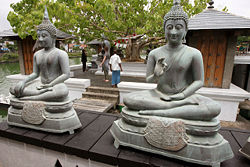
Colombo is the most populated city in Sri Lanka, with 642,163 people living within the limits of this multi-ethnic, multi-cultural city. Sinhalese make up 41.36 percent of the city's population, Moors 23.87 percent, and Tamils 28.91 percent. There are small communities of people with Chinese, Portuguese, Dutch, Malay (1.73 percent), and Indian Tamil (2.17 percent) origins living in the city, as well as numerous European expatriates.
Sinhala and Tamil are the two official languages. English is spoken by approximately 10 percent of the population, and is widely used for education, scientific, and commercial purposes. Members of the Burgher community (male-line descendants]] of European colonists from the sixteenth to twentieth centuries (Eurasian descendants of Portuguese, Dutch, and British men and local women) speak variant forms of Portuguese Creole and Dutch.
Approximately 68 percent of Sri Lankan people are adherents of Buddhism. Theravada Buddhism is the predominant school. Hinduism is practiced by 18 percent, mainly from the Tamil community, Christianity is practiced by up to eight percent, especially by the Portuguese and Dutch Burgher people. While most Sri Lankan Christians are Catholics, there are also significant numbers who adhere to Dutch Reformed Church and the Anglican Communion.
The Colombo Medical School and the Colombo Law College were established in the 1870s. The Ceylon University College was established in 1913, followed by the formation of the University of Ceylon, which had a campus in Colombo. The University of Colombo and the University of the Visual and Performing Arts are state universities located in Colombo, while the Sri Lanka Institute of Information Technology has a metropolitan campus there.
The most popular sport in Sri Lanka is cricket. The country won the 1996 Cricket World Cup and became runners up in 2007. Colombo has two international cricket stadiums, the Sinhalese Sports Club's cricket stadium and R. Premadasa Stadium. Rugby is a popular sport at the club and school level.
Places of interest
Buildings from the Portuguese, the Dutch and the British eras stand as reminders of the city's turbulent past. The Dutch Hospital, now the Colombo Dutch Museum, is the oldest building in the fort area. The President's House (formally the Queen's House) had originally been the Dutch governors house.
Buildings of the British era include the old Parliament building, which is now the Presidential Secretariat, the Republic Building which houses the Ministry of Foreign affairs, the Treasury building, the old General Post Office, the Prime Minister's Office, and the mathematics department of the University of Colombo. Notable commercial buildings of the British era include, the Galle Face Hotel, Cargills & Millers complex, Grand Oriental Hotel. Several old clubs, including the Orient Club, the 80s Club, and the Colombo Cricket Club, give a glimpse of the British lifestyle.
The Galle Face Green is the city's largest and most elegant promenade. Lined with palm trees and adjacent to the coast, this mile-long stretch in the heart of the city is especially busy on Fridays and Saturdays.
Colombo's most beautiful festival is the celebration of Buddha's birth, enlightenment and death, which takes place in mid-May and lasts a week. During this festival, much of the city is decorated with lanterns, lights and special displays of light, known as Thoran.
Colombo has several performing arts centers. The most famous are the Lionel Wendt Theater, the Elphinstone and the Tower Hall. The Navarangahala is the country's first national theater.
The National Museum of Colombo, established in 1877, houses the crown jewels and throne of the last king of the Kingdom of Kandy, Sri Vikrama Rajasinha. The Colombo Dutch Museum details Dutch colonial history. There is only a small collection of Sri Lankan masterpieces at the Art Gallery in Green Path.
Looking to the future
Colombo is both a modern and an ancient city. Possessing a natural harbor, it was known to Roman, Arab, and Chinese traders more than 2,000 years ago. It has been controlled by various foreign nations throughout its history. Buildings from the Portuguese, the Dutch and the British eras stand as reminders of the turbulent past.
Located on Sri Lanka's west coast, just south of the Kelani River, it is a principal port of the Indian Ocean. Its natural harbor, which drew foreigners to its doorstep in ancient days, has been expanded and is today one of the largest artificial harbors in the world. The majority of the nation's foreign trade flows through its ports.
Colombo is the largest city and commercial capital of Sri Lanka, and is home to many of the national governmental institutions. Known as a busy and vibrant city, it is nonetheless restricted by the political turbulence that has continued since independence. The demands of the Tamil Tigers separatist fighters has yet to be resolved, and conflict between ethnic and caste lines continues. Poverty remains, and successive governments have seesawed between state and market-oriented solutions to raise GDP.
Sri Lanka rightly fought for its independence from foreign domination, but must now fight to overcome the barriers of race and ethnicity in order to experience real freedom and prosperity. Colombo's situation is intricately tied to that of Sri Lanka; its situation will improve hand in hand with that of its nation.
Notes
- ↑ Census July 17, 2001 (via Citypopulation.de) Retrieved October 17, 2011.
- ↑ Padma Edirisinghe, Colombo—then and now, The Sunday Observer.
- ↑ World Executive, Colombo City Guide. Retrieved September 18, 2008.
ReferencesISBN links support NWE through referral fees
- Brohier, Richard Leslie, and Ismeth Raheem. Changing Face of Colombo, 1505-1972: Covering the Portuguese, Dutch, and British Periods. Colombo: Lake House Investments, 1984. OCLC 12345141
- Dharmasena, K. The Port of Colombo, 1860-1939. Colombo: Ministry of Higher Education (Sri Lanka), 1980. OCLC 59683734
- Perera, Nihal. Decolonizing Ceylon: Colonialism, Nationalism, and the Politics of Space in Sri Lanka. New Delhi: Oxford University Press, 1999. ISBN 9780195646436
- World Fact Book. Sri Lanka.
External links
All links retrieved January 7, 2024.
Credits
New World Encyclopedia writers and editors rewrote and completed the Wikipedia article in accordance with New World Encyclopedia standards. This article abides by terms of the Creative Commons CC-by-sa 3.0 License (CC-by-sa), which may be used and disseminated with proper attribution. Credit is due under the terms of this license that can reference both the New World Encyclopedia contributors and the selfless volunteer contributors of the Wikimedia Foundation. To cite this article click here for a list of acceptable citing formats.The history of earlier contributions by wikipedians is accessible to researchers here:
The history of this article since it was imported to New World Encyclopedia:
Note: Some restrictions may apply to use of individual images which are separately licensed.
